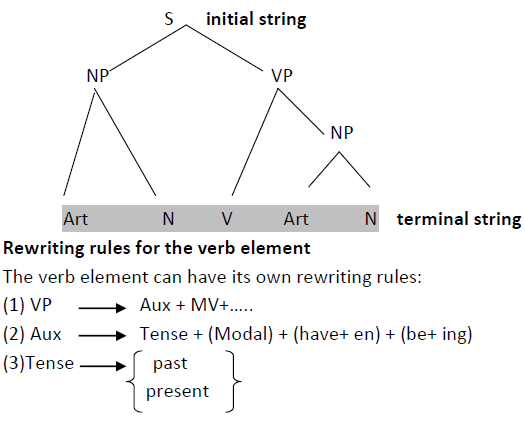1. The Classical Theory
1.1. Phrase Structure Rules
Phrase structure rules (rewriting rules) expand the sentence (S), the largest unit of grammar into smaller units. They show the internal grammatical structures of constituents using symbols. There is always one symbol to the left of the arrow. The arrow means: “is to be rewritten as” and it has one direction. Each symbol represents a constituent. Some of these rules are categorical (they translate abstract elements into other abstract elements); others are lexical (they translate the abstract elements into concrete vocabulary items). PS rules are ordered and each one is derived from some previous one. It is possible to use a phrase marker (a diagrammatic representation) to show PS rules. It is a tree diagram which has branches (lines) and nodes (dots). One node above the other on a diagram dominates the lower node.

Rule (1) indicates that the VP contains (an) auxiliary (s) and a main verb. Other elements are possible depending on the pattern of sentences (SVO, SVC, SVOC, SVC…). The other structures of VP are related to the type of verb used (transitive, intransitive, copular). So, rule (1) can have the following forms:
VP ------ Aux + MV + NP
VP------- Aux + MV + Adj
VP------- Aux + MV + NP + Adj
Rule (2) indicates that the auxiliary element contains:
- Tense (obligatory): English sentences must have a tense.
- A modal auxiliary (optional): English sentences can have mood)
- A perfect auxiliary (optional): English sentences can have a perfect aspect expressed in the auxiliary “have” which needs a past participle morpheme “en”.
- A progressive auxiliary (English sentences can have a progressive aspect expressed in the auxiliary “be” which needs a present participle morpheme “ing”.
Rule (3) indicates that there are 2 tenses in English (present or past)
When rule (2) is used with rule (3) we can generate all possible combinations of auxiliaries with ain verbs in all active declarative sentences in English.
Example:
